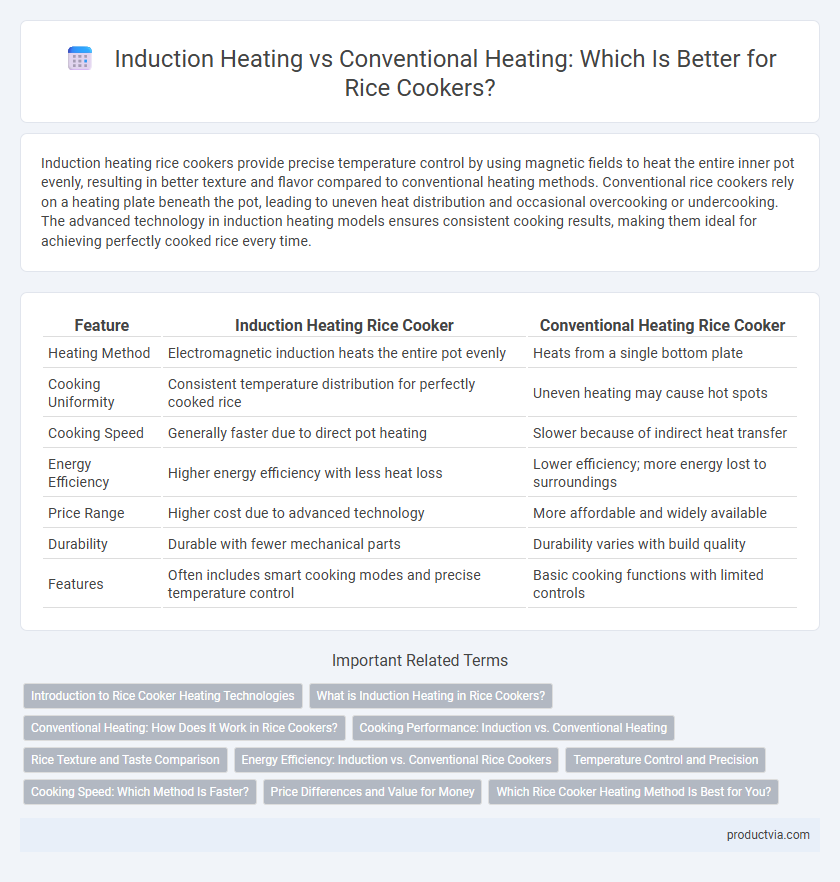Induction heating rice cookers provide precise temperature control by using magnetic fields to heat the entire inner pot evenly, resulting in better texture and flavor compared to conventional heating methods. Conventional rice cookers rely on a heating plate beneath the pot, leading to uneven heat distribution and occasional overcooking or undercooking. The advanced technology in induction heating models ensures consistent cooking results, making them ideal for achieving perfectly cooked rice every time.
Table of Comparison
| Feature | Induction Heating Rice Cooker | Conventional Heating Rice Cooker |
|---|---|---|
| Heating Method | Electromagnetic induction heats the entire pot evenly | Heats from a single bottom plate |
| Cooking Uniformity | Consistent temperature distribution for perfectly cooked rice | Uneven heating may cause hot spots |
| Cooking Speed | Generally faster due to direct pot heating | Slower because of indirect heat transfer |
| Energy Efficiency | Higher energy efficiency with less heat loss | Lower efficiency; more energy lost to surroundings |
| Price Range | Higher cost due to advanced technology | More affordable and widely available |
| Durability | Durable with fewer mechanical parts | Durability varies with build quality |
| Features | Often includes smart cooking modes and precise temperature control | Basic cooking functions with limited controls |
Introduction to Rice Cooker Heating Technologies
Induction heating rice cookers utilize electromagnetic fields to heat the entire inner pot evenly, resulting in precise temperature control and consistent cooking performance. Conventional heating models rely on a heating plate beneath the pot, which often leads to uneven heat distribution and longer cooking times. The advanced technology in induction heating supports improved rice texture and enhanced flavor extraction compared to traditional methods.
What is Induction Heating in Rice Cookers?
Induction heating in rice cookers uses electromagnetic fields to directly heat the inner pot, providing precise temperature control and even heat distribution. Unlike conventional heating, which relies on a heating element beneath the pot, induction heating allows for faster cooking and improved texture by heating the rice more uniformly. This technology enhances energy efficiency and ensures perfectly cooked rice by maintaining consistent temperatures throughout the cooking process.
Conventional Heating: How Does It Work in Rice Cookers?
Conventional heating in rice cookers uses a heating plate located beneath the cooking pot to transfer heat through direct contact, gradually warming the pot and cooking the rice. This method relies on simple thermal conduction and is generally more affordable but offers less precise temperature control compared to induction heating. The consistent heat distribution in conventional rice cookers is effective for basic cooking needs but may result in uneven cooking or longer cooking times.
Cooking Performance: Induction vs. Conventional Heating
Induction heating rice cookers deliver precise temperature control by generating heat directly within the pot, resulting in even cooking and enhanced rice texture compared to conventional heating methods that rely on an external heating plate. This technology enables rapid heating and consistent heat distribution, reducing cooking time and preventing hotspots that cause unevenly cooked rice. Conventional rice cookers often produce less uniform results due to indirect heat transfer, leading to potential overcooked edges and undercooked centers.
Rice Texture and Taste Comparison
Induction heating rice cookers provide more precise and even heat distribution, resulting in rice with a consistently fluffy texture and enhanced natural sweetness. Conventional heating models often cause uneven cooking, leading to rice that may be partially overcooked or undercooked with less distinct flavor. Tests show induction heating yields a softer, more aromatic rice, preferred for premium varieties like jasmine and basmati.
Energy Efficiency: Induction vs. Conventional Rice Cookers
Induction heating rice cookers use electromagnetic fields to heat the inner pot directly, resulting in faster and more uniform cooking with less energy consumption. Conventional rice cookers rely on a heating plate that transfers heat indirectly, often causing uneven heating and longer cooking times, which leads to higher energy usage. Studies show induction rice cookers can be up to 30% more energy-efficient than conventional models, making them a more eco-friendly choice.
Temperature Control and Precision
Induction Heating rice cookers offer superior temperature control by using electromagnetic fields to heat the entire inner pot uniformly, ensuring precise and consistent cooking temperatures. Conventional Heating rice cookers rely on a heating plate that heats the pot from the bottom, often resulting in uneven heat distribution and less accurate temperature regulation. Enhanced precision in Induction Heating models leads to better texture and flavor in cooked rice compared to conventional methods.
Cooking Speed: Which Method Is Faster?
Induction heating rice cookers use electromagnetic waves to directly heat the inner pot, resulting in faster and more even cooking compared to conventional heating that relies on a heating plate beneath the pot. Induction models typically reduce cooking time by 10-20%, making them more efficient for preparing various types of rice. Conventional heating methods often have slower heat transfer, causing longer cooking durations and less precise temperature control.
Price Differences and Value for Money
Induction heating rice cookers are generally priced higher than conventional heating models due to advanced technology offering precise temperature control and even cooking. Conventional rice cookers, while more affordable, often lack the consistent heat distribution of induction types, resulting in less uniform rice texture. Consumers seeking long-term durability and optimal cooking performance tend to find better value in induction heating rice cookers despite the higher initial investment.
Which Rice Cooker Heating Method Is Best for You?
Induction heating rice cookers offer faster, more even heat distribution by using electromagnetic currents, resulting in perfectly cooked rice with enhanced texture and flavor. Conventional heating models rely on a heating plate beneath the pot, leading to slower, less consistent cooking outcomes. Choosing between the two depends on your budget, cooking frequency, and preference for precise temperature control versus affordability.
Induction Heating vs Conventional Heating for rice cookers Infographic

 productvia.com
productvia.com